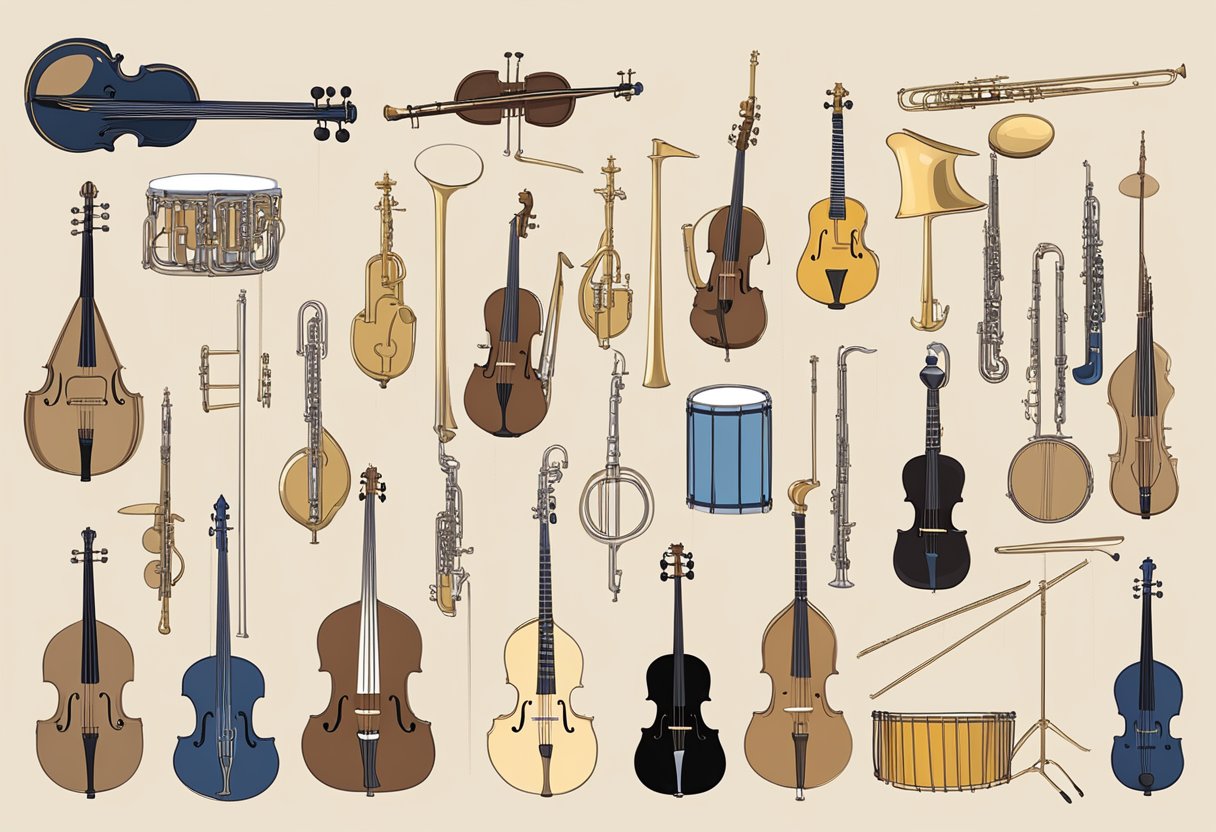Types Of Instruments
Musical instruments are tools used to create sound through vibration. They come in various shapes and sizes and are made of different materials depending on their purpose. The classification of instruments is based on the way they produce sound, their range of tones, and their function.
String, wind, percussion, and keyboard instruments are the four main categories of instruments. String instruments produce sound by vibrating strings, which are usually made of metal or gut. Wind instruments produce sound by blowing air into them, while percussion instruments create sound by striking or shaking them. Keyboard and electronic instruments produce sound through the manipulation of electrical signals.
Each category of instruments has its unique characteristics and range of tones. String instruments are known for their warm and rich sound, while wind instruments produce a variety of sounds, from soft and mellow to loud and piercing. Percussion instruments are known for their rhythmic qualities, while keyboard and electronic instruments offer a wide range of sounds and effects.
Key Takeaways
- Musical instruments are tools used to create sound through vibration and come in various shapes and sizes made of different materials depending on their purpose.
- The four main categories of instruments are string, wind, percussion, and keyboard, each with its unique characteristics and range of tones.
- String instruments produce sound by vibrating strings, wind instruments by blowing air into them, percussion instruments by striking or shaking them, and keyboard and electronic instruments through the manipulation of electrical signals.
Classification of Instruments

Instruments can be classified in many ways depending on various criteria. This section will cover two of the most common ways of classifying instruments: by sound production and by material and design.
By Sound Production
Instruments can be classified into four main categories based on how they produce sound: idiophones, membranophones, chordophones, and aerophones.
- Idiophones: These instruments produce sound through the vibration of the entire instrument itself. Examples of idiophones include bells, cymbals, and xylophones.
- Membranophones: These instruments produce sound by vibrating a stretched membrane, such as a drumhead. Examples of membranophones include drums and tambourines.
- Chordophones: These instruments produce sound by vibrating strings. Examples of chordophones include guitars, violins, and harps.
- Aerophones: These instruments produce sound by vibrating air. Examples of aerophones include flutes, trumpets, and bagpipes.
By Material and Design
Instruments can also be classified based on their material and design. Here are some common classifications:
- Woodwind instruments: These instruments are made of wood and produce sound by blowing air through a mouthpiece. Examples of woodwind instruments include flutes, clarinets, and saxophones.
- Brass instruments: These instruments are made of brass and produce sound by buzzing the lips into a mouthpiece. Examples of brass instruments include trumpets, trombones, and tubas.
- String instruments: These instruments have strings that are stretched over a resonating chamber and produce sound by vibrating the strings. Examples of string instruments include guitars, violins, and cellos.
- Percussion instruments: These instruments produce sound by striking or shaking them. Examples of percussion instruments include drums, cymbals, and maracas.
- Electronic instruments: These instruments produce sound electronically using synthesizers, drum machines, and other electronic devices.
In conclusion, instruments can be classified in many ways based on different criteria. The two most common classifications are by sound production and by material and design. By understanding these classifications, one can gain a better understanding of the different types of instruments and how they produce sound.
String Instruments
String instruments are musical instruments that produce sound by vibrating strings. These instruments are classified into three main categories: bowed strings, plucked strings, and struck strings.
Bowed Strings
Bowed string instruments are played by drawing a bow across the strings, which causes them to vibrate and produce sound. The most popular bowed string instruments include the violin, viola, cello, and double bass. The bow is an essential part of these instruments, and it is made of a stick and horsehair. The bow is used to create different types of sound, such as staccato, legato, and spiccato.
Plucked Strings
Plucked string instruments are played by plucking the strings with the fingers or a plectrum. The most popular plucked string instruments include the guitar, harp, and banjo. These instruments produce a sound that is different from bowed string instruments, and they are used in a variety of musical genres, including folk, rock, and classical.
Struck Strings
Struck string instruments are played by striking the strings with hammers or mallets. The most popular struck string instrument is the piano. The piano has strings that are struck by hammers when the keys are pressed. The harpsichord is another example of a struck string instrument.
String instruments are an essential part of many musical genres, including classical, folk, and rock. They are versatile instruments that can produce a wide range of sounds, from soft and delicate to loud and powerful. The vibrating strings on these instruments are responsible for producing the sound, and the way they are played can have a significant impact on the final result.
Wind Instruments
Wind instruments are a family of musical instruments that produce sound by the vibration of air within a column. There are two main types of wind instruments: woodwinds and brass.
Woodwinds
Woodwind instruments are characterized by the use of a reed or an air column to produce sound. The reed is a thin strip of material that vibrates when air is blown through it. The air column is a tube that produces sound when air is blown across its opening.
Some of the most common woodwind instruments include the flute, oboe, clarinet, saxophone, and bassoon. The flute is a simple tube with finger holes, while the oboe and clarinet use a reed to produce sound. The saxophone and bassoon are larger instruments that produce a deeper, richer sound.
Brass
Brass instruments are characterized by the use of a mouthpiece and a metal tube to produce sound. The mouthpiece is a small cup-shaped device that the player blows into to create a buzzing sound. The metal tube, which is often curved, amplifies the sound and produces different notes when the player changes the length of the tube.
Some of the most common brass instruments include the trumpet, trombone, French horn, and tuba. The trumpet and trombone are both straight metal tubes, while the French horn and tuba are curved. Each instrument produces a unique sound and requires a different playing technique.
Overall, wind instruments are a versatile and important part of the musical world. Whether you prefer the bright, clear sound of a flute or the deep, rich tones of a tuba, there is a wind instrument out there for every musician.
Percussion Instruments
Percussion instruments are those that produce sound by being struck, shaken, or scraped. They are an essential part of any musical ensemble and can be found in a wide variety of genres, from classical to rock to jazz. Percussion instruments can be divided into two main categories: pitched and unpitched.
Pitched Percussion
Pitched percussion instruments are those that produce a definite pitch or note when struck. These instruments are often used to play melodies or harmonies in an ensemble. Examples of pitched percussion instruments include the xylophone, timpani, and bells.
The xylophone is a percussion instrument that consists of a set of wooden bars that are struck with mallets to produce a sound. The bars are arranged in order of pitch, with the lowest pitch on the left and the highest pitch on the right. The xylophone is often used in orchestral music and can be found in a variety of genres.
The timpani, also known as kettle drums, are a type of drum that produces a definite pitch when struck. They are often used in orchestral music and can be found in a variety of genres. The timpani consists of a large bowl-shaped drum with a skin stretched over the top. The pitch of the drum can be changed by tightening or loosening the skin.
Bells are another example of a pitched percussion instrument. They are often used in orchestral music and can be found in a variety of genres. Bells can be made from a variety of materials, including brass, bronze, and steel. They produce a clear, ringing sound when struck.
Unpitched Percussion
Unpitched percussion instruments are those that do not produce a definite pitch or note when struck. These instruments are often used to provide rhythm and texture to an ensemble. Examples of unpitched percussion instruments include the drum, cymbal, and tambourine.
The drum is a percussion instrument that consists of a hollow shell and a drumhead stretched over the top. It produces a deep, resonant sound when struck. Drums can be found in a variety of genres, from rock to jazz to world music.
Cymbals are another example of an unpitched percussion instrument. They consist of two metal plates that are struck together to produce a crashing sound. Cymbals are often used in rock and jazz music.
The tambourine is a percussion instrument that consists of a circular frame with metal jingles attached to it. It is often used in folk and world music and can be played by shaking or striking the instrument.
In conclusion, percussion instruments are an essential part of any musical ensemble. They can be divided into two main categories: pitched and unpitched. Pitched percussion instruments produce a definite pitch or note when struck, while unpitched percussion instruments do not. Examples of percussion instruments include the drum, xylophone, cymbal, and tambourine.
Keyboard and Electronic Instruments
Keyboard instruments are a type of musical instrument that is played using a keyboard. These instruments produce sound by striking strings or by using electronic means to generate sound. There are two main types of keyboard instruments: acoustic and electronic.
Acoustic Keyboards
The most well-known acoustic keyboard instrument is the piano. The piano is a large, heavy instrument with 88 keys. It produces sound by striking strings with hammers when the keys are pressed. The piano is a versatile instrument that can be used in many different styles of music, from classical to jazz to pop.
Another type of acoustic keyboard instrument is the harpsichord. The harpsichord is similar to the piano, but it produces sound by plucking strings instead of striking them with hammers. The harpsichord was a popular instrument in the Baroque era and is still used today in some classical music.
Electronic Keyboards
Electronic keyboards are a type of keyboard instrument that uses electronic technology to generate sound. There are many different types of electronic keyboards, including synthesizers, digital pianos, and organs.
Synthesizers are electronic instruments that can produce a wide range of sounds. They are often used in electronic music and can be used to create unique sounds that are not possible with acoustic instruments.
Digital pianos are electronic instruments that are designed to replicate the sound and feel of a traditional piano. They are often used in home settings or in small performances where a full-sized piano is not practical.
Organs are keyboard instruments that produce sound by using pipes or electronic means. They are often used in churches and other religious settings, but they can also be used in other types of music.
Overall, keyboard instruments are a versatile and important part of the musical world. Whether you are playing an acoustic piano or an electronic synthesizer, there is a keyboard instrument that is right for you.


